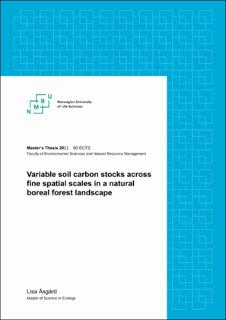| dc.description.abstract | Boreal forests, and especially boreal forest soils, are of considerable importance in global carbon dynamics and climate regulation. There are several studies that have modelled and quantified boreal soil carbon stocks, but we still lack knowledge about how much the size of these stocks varies across fine spatial scales, and the factors controlling this variation. Identifying these factors are crucial to understand and predict how global change might affect the forest’s role as a carbon source or sink. Here, I quantify carbon stocks, investigate their spatial variability, and make an attempt to identify the factors that control soil carbon content in a natural boreal forest landscape located in the Trillemarka – Rollagsfjell nature reserve, SE Norway. My study is based on the analysis of 189 organic top soil profiles that were collected by a regular grid approach within a 0.1 km2 forest area. Dominant forest ground vegetation, topography, tree basal area, nitrogen percent, and fire history (years since last fire and fire frequency) were tested as explanatory variables for soil carbon content, soil depth and soil nitrogen content. I also investigated drivers of carbon- and nitrogen concentrations, C:N-ratios, and soil bulk densities.
My results showed large variations in soil carbon contents, ranging from 1.4 to 96.5 kg m-2. Similarly, I found large variations in soil depths and soil nitrogen contents. Sphagnum-dominated plots had the highest carbon content, and lichen-dominated plots the lowest. Generally, dominant bottom vegetation was important for explaining the fine-scale variation in carbon content. There was a negative relationship between soil carbon content and C:N-ratio, while the relationship was positive between carbon content and nitrogen concentration. Tree species composition and basal area also explained some variation in carbon content, but contrary with our expectations, spruce and pine basal area had a negative relationship with carbon content, while deciduous basal area had a positive relationship with carbon content. This implies that dominant ground vegetation and the associated soil properties might be of higher importance. I found no impact of fire history on soil carbon content.
My thesis highlights the importance of considering spatial scales when investigating carbon stocks. In addition, I emphasize that including several explanatory variables is necessary to obtain reliable estimates and sufficient understanding of boreal soil carbon dynamics. | en_US |

